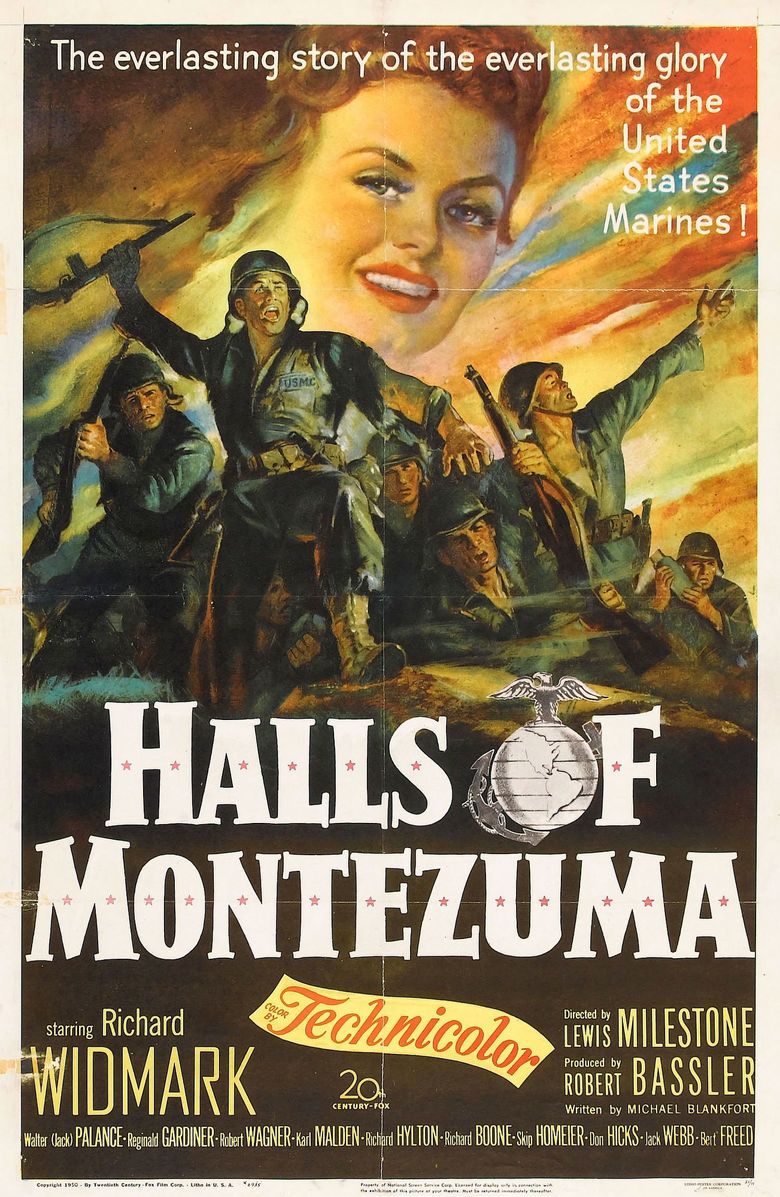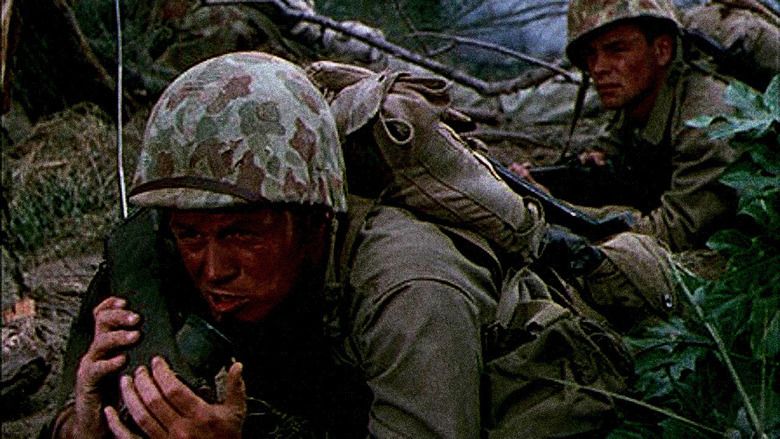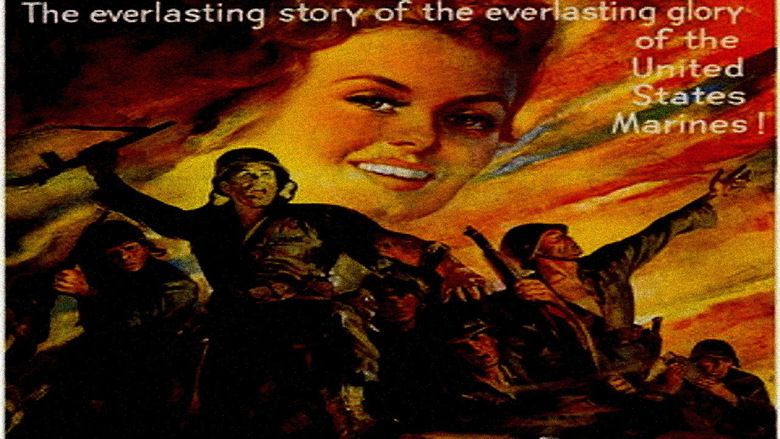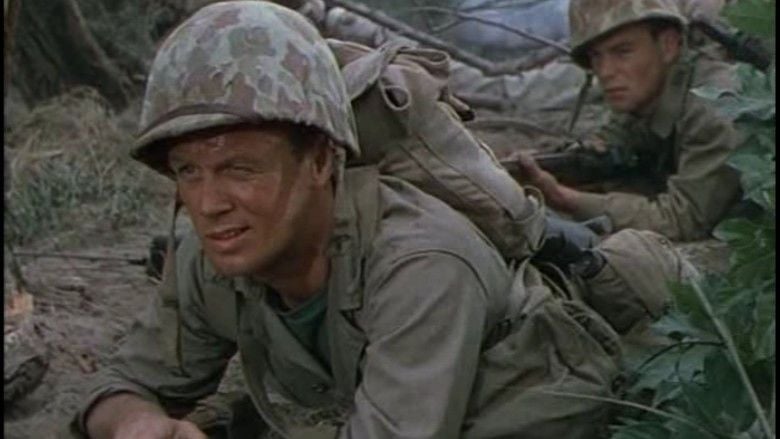Halls of Montezuma (film)
7.6 /10 1 Votes7.6
83% Rotten Tomatoes Genre Adventure, War, Drama Language English | 6.7/10 IMDb Initial DVD release May 21, 2002 Duration Country United States | |||||||||||||||||||||||||||||||||
 | ||||||||||||||||||||||||||||||||||
Release date January 4, 1951 Cast (Lt. Anderson), (Pigeon Lane), (Doc), (Lt. Col. Gilfillan), (Correspondent Dickerman), (Coffman) Similar movies From Dusk Till Dawn , Maximum Overdrive , The Messenger: The Story of Joan of Arc , 55 Days at Peking , Dead Presidents , Khartoum | ||||||||||||||||||||||||||||||||||
Halls of montezuma theatrical movie trailer 1951
Halls of Montezuma is a 1951 World War II war film starring Richard Widmark, Richard Boone, Jack Palance and Karl Malden. The film, which is about U.S. Marines fighting on a Japanese-held island, was directed by Academy Award-winner Lewis Milestone. It also starred Robert Wagner in his first credited screen role and featured Richard Boone in his feature film debut. Real color combat footage from the war in the Pacific was incorporated into the film's cinematography.
Contents
- Halls of montezuma theatrical movie trailer 1951
- Halls of montezuma
- Plot
- Casting
- Filming
- Direction
- Release
- References

Filmed on location at Camp Pendleton, California, with the full cooperation of the USMC. Its title is a reference to the opening line from the Marines' Hymn.

Halls of montezuma
Plot

During World War II, a Marine battalion prepares to land on a large Japanese-held island in the Pacific. Lieutenant Colonel Gilfillan (Richard Boone) warns the men that it will be a tough mission, and that they have been ordered to take prisoners in order to gain information about the Japanese fortifications. Below deck, veteran Lieutenant Carl A. Anderson (Richard Widmark), a chemistry teacher in civilian life, questions his former student, Corporal Stuart Conroy (Richard Hylton), who complains that he is ill and cannot fight. Anderson assures him that he has shown courage before and can do so again. In the landing boat heading to shore, Navy corpsman C. E. "Doc" Jones (Karl Malden) is worried because Anderson has been suffering from "psychological migraines" for months. Anderson and his platoon have been fighting since Guadalcanal, and now only seven men remain of the original platoon. Although Doc urged Anderson to seek treatment in the United States, Anderson refuses to leave his men and has been relying on Doc to supply him with painkillers.

The men hit the beach and successfully dig in, despite an initial burst of resistance. As four days pass, the seven old-timers in Anderson's platoon, including Doc, Pigeon Lane (Jack Palance), Sergeant Zelenko (Neville Brand), Slattery (Bert Freed), Coffman (Robert Wagner) and the unstable Riley "Pretty Boy" Duncannon (Skip Homeier), grow weary of the constant threat of hidden Japanese snipers. One day, the men try to take a ridge of hills, but are beaten back by Japanese rockets, which come as an unpleasant surprise to the commanding officers. When Coffman (whom Anderson saved from drowning at Tarawa) is killed, Anderson is forced to take some more of Doc's pills.
Anderson meets with other officers at battalion headquarters, where Gilfillan recounts the troubles they are having capturing prisoners and getting information from them. Sergeant Randolph Johnson (Reginald Gardiner), a Japanese-speaking linguist who uses psychology in interrogating prisoners, questions a POW who has been dubbed "Willie". As Gilfillan receives orders to stop the rockets within nine hours, before the next assault on the hills, Willie informs Johnson that the Japanese soldiers holding a cave stronghold are willing to surrender. Accompanied by Johnson and war correspondent Sergeant Dickerman (Jack Webb), Anderson leads a patrol with the six remaining old-timers and replacement Whitney (Martin Milner) to the cave, but they are ambushed and Zelenko is blinded.
The men capture the remaining Japanese, including a wounded officer, three laborers and a shell-shocked, elderly civilian. Anderson finds a map on the wounded officer. On the return trip, a sniper shoots at Pretty Boy, who kills him during hand-to-hand combat. The confrontation further unbalances him and he attempts to murder the prisoners. Lane then accidentally shoots and kills Pretty Boy while attempting to stop him. Doc also dies from a wound in the shoulder, but not before giving Dickerman a message for Anderson.
Anderson takes his prisoners to headquarters, where the wounded officer commits hara-kiri with a knife he had stolen from Johnson. While map expert Lieutenant Butterfield works on a Japanese map overlay found in Pretty Boy's personal effects, Anderson and Johnson learn that one of the POWs is actually a highly educated officer, and famous Japanese baseball player before the war, pretending to be a private. From the officer's cryptic statements (he speaks perfect English), together with statements made from the officer who committed suicide, Johnson deduces where the rockets are located, and Lieutenant Butterfield matches the location on the map. When Anderson and Dickerman make their way back to the platoon, they learn from Slattery that Conroy has been killed. Anderson takes the news hard, questions the meaning of their sacrifice, and is ready to give up. Dickerman reads aloud Doc's note, however, and Anderson, inspired by Doc's appeal for him to be strong for the sake of those whom he survives and the reciting of the Lord's Prayer by Whitney, throws away his painkillers, smashing them with the butt of his weapon, and again leads his men into battle. Then, as the film closes, U.S. Corsairs fly in and smash the Japanese position, which they were able to attack based on Anderson's men's efforts, Anderson screams to the advancing troops: "Give 'em Hell," which they echo in unison.
Casting
According to a January 1949 Los Angeles Times, actors Dana Andrews, Anne Baxter and Paul Douglas were originally set to star in the picture. However, they were not cast in the film.
Filming
The film used various locations around Camp Pendleton and the adjacent Pacific coast for the landing scenes. The USMC also provided accurate military equipment, such as weapons, tanks and uniforms, as well as providing the manpower to create the logistics of a wartime U.S. Marine battalion.
Direction
This was the last American-made World War II film directed by Lewis Milestone. After the Halls of Montezuma, he made films in Europe as well as other movie genres such as the Rat Pack caper film, Ocean's 11. In 1959 he directed the acclaimed Pork Chop Hill, starring Gregory Peck, his final war film set during the Korean War.
Release
Serving U.S. Marines and Second World War veterans attended the film's premieres in New York and Los Angeles. Proceeds from the premieres were donated to various charities associated with the United States Marine Corps. The studio also allowed the USMC to use the film for recruitment purposes. On January 11, 1951, The Hollywood Reporter noted that a full company of Marine recruits were to be sworn in at the film's premiere in San Francisco.
References
Halls of Montezuma (film) WikipediaHalls of Montezuma (film) IMDbHalls of Montezuma (film) Rotten TomatoesHalls of Montezuma (film) themoviedb.org
